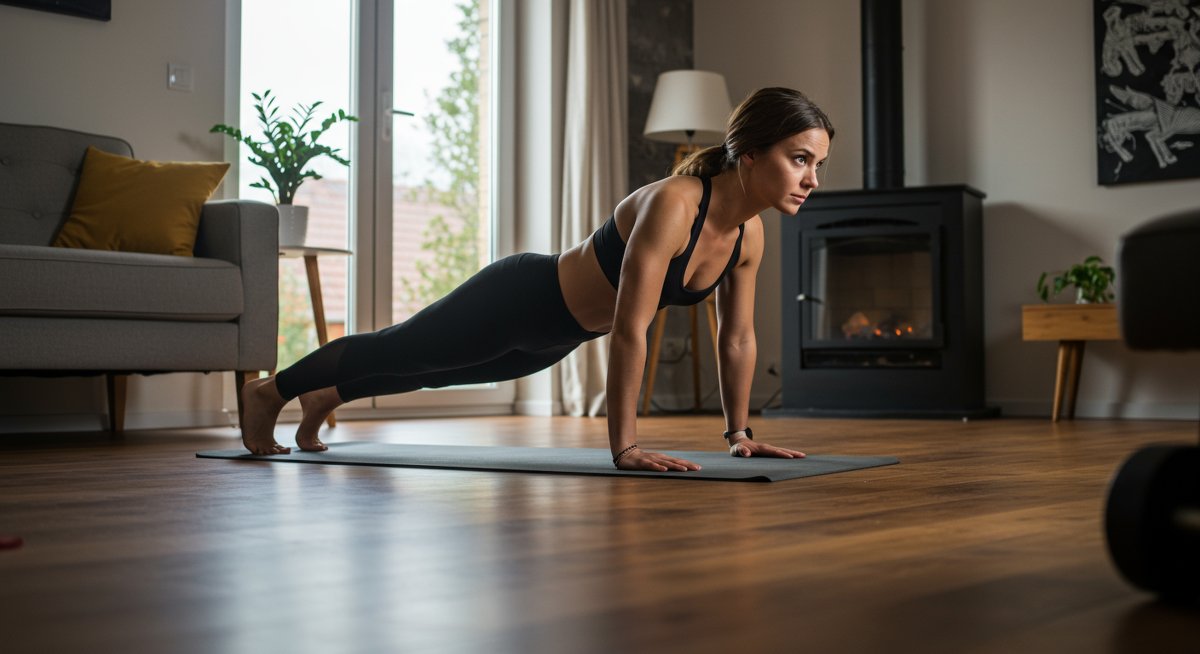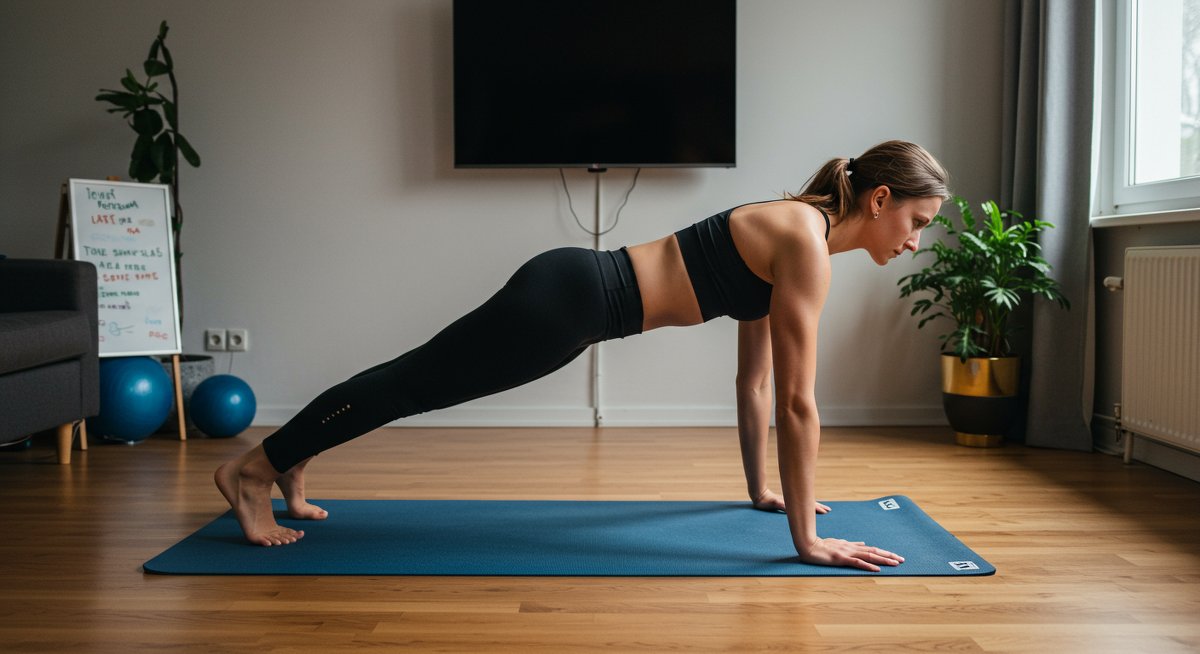Are you ready to take your home fitness to the next level? This guide is designed specifically for intermediate fitness enthusiasts seeking a challenging and effective bodyweight workout. Forget expensive gym memberships and bulky equipment – we're focusing on building serious strength using just your body. This workout is perfect for those with some experience, providing detailed instructions, advanced variations, and expert tips to help you maximize your results at home.

Mastering Key Techniques for This Workout
Before diving into the exercises, it's crucial to understand proper form and technique. This ensures you're targeting the right muscles and preventing injuries. Let's break down the key techniques for each exercise:
1. Push-Ups:
- Proper Form: Hands shoulder-width apart, body in a straight line from head to heels, engage your core, lower your chest towards the ground, and push back up.
- Common Mistakes: Sagging hips, flared elbows, and not going low enough.
- Expert Tip: Focus on controlled movements. Aim for a slow descent (3 seconds) and a powerful push-up.
- Example: Start by performing 3 sets of as many reps as possible (AMRAP) with perfect form.
2. Squats:
- Proper Form: Feet shoulder-width apart, chest up, back straight, and lower your hips as if sitting in a chair. Your thighs should be parallel to the ground (or lower).
- Common Mistakes: Leaning forward, knees caving in, and not going deep enough.
- Expert Tip: Engage your core throughout the movement and keep your weight on your heels.
- Example: Try a set of 15-20 reps with a slow, controlled descent and powerful ascent.
3. Lunges:
- Proper Form: Step forward with one leg, lowering your body until both knees are bent at 90-degree angles. Keep your front knee over your ankle.
- Common Mistakes: Knee going past your toes, not lowering enough, and leaning forward.
- Expert Tip: Focus on keeping your balance and engaging your core to stabilize your body.
- Example: Alternate legs for 3 sets of 10-12 reps per leg.
4. Plank:
- Proper Form: Forearms on the ground, body in a straight line from head to heels, engage your core, and hold.
- Common Mistakes: Sagging hips, raised hips, and not engaging the core.
- Expert Tip: Squeeze your glutes and brace your core as if you're about to be punched in the stomach.
- Example: Aim for 3 sets, holding for as long as you can maintain perfect form (30-60 seconds).
5. Superman:
- Proper Form: Lie face down with arms and legs extended. Simultaneously lift your arms, chest, and legs off the floor. Engage your lower back muscles.
- Common Mistakes: Lifting too high, not engaging the core, and arching the lower back excessively.
- Expert Tip: Focus on controlled movements and squeezing your lower back muscles.
- Example: Perform 3 sets of 10-15 reps, holding each lift for 1-2 seconds.
Advanced Variations and Progressions
Once you've mastered the basic techniques, it's time to increase the challenge. Here are some advanced variations and progressions for each exercise:
- Push-Ups:
- Progression: Decline push-ups (feet elevated), clap push-ups (explosive push), and diamond push-ups (hands close together).
- Example: Perform 3 sets of 8-12 reps of decline push-ups.
- Squats:
- Progression: Jump squats (explosive jump at the top), pistol squats (one-legged squat), and Bulgarian split squats (rear foot elevated).
- Example: Do 3 sets of 10 reps of jump squats.
- Lunges:
- Progression: Walking lunges (moving forward with each lunge), reverse lunges with a jump, and lateral lunges.
- Example: Perform 3 sets of 10 walking lunges per leg.
- Plank:
- Progression: Plank with shoulder taps, plank with leg lifts, and side planks.
- Example: Hold a side plank for 30-45 seconds on each side, for 3 sets.
- Superman:
- Progression: Superman with arm and leg raises, superman with a hold, and alternating arm and leg raises.
- Example: Perform 3 sets of 10 reps of superman with arm and leg raises.
Maximizing Your Results at Home
To achieve optimal results with your bodyweight strength training, consider these advanced training principles:
Progressive Overload: Gradually increase the difficulty of your workouts. This can be done by increasing reps, sets, hold times, or adding more challenging variations of the exercises.
- Example: If you can do 10 push-ups with good form, try to increase it to 12, 15, and eventually more.
Workout Frequency and Volume: Aim to train 3-4 times per week, allowing for rest days in between. Adjust the number of sets and reps based on your fitness level.
- Example: For an intermediate, try 3-4 sets of 10-15 reps of each exercise, 3 times a week.
Rest and Recovery: Proper rest and recovery are essential for muscle growth and preventing overtraining. Ensure you get adequate sleep (7-9 hours) and eat a balanced diet.
- Example: Incorporate active recovery like light cardio or stretching on rest days.
Nutrition: Focus on consuming adequate protein to support muscle repair and growth. Aim for 0.8-1 gram of protein per pound of body weight daily.
- Example: Include lean meats, poultry, fish, eggs, and plant-based protein sources in your diet.
Mind-Muscle Connection: Focus on contracting the target muscles during each exercise. This will help you maximize the effectiveness of your workout.
- Example: Concentrate on squeezing your glutes during squats and feeling the burn in your chest during push-ups.
Advanced Training Principles
- Supersets: Combine two exercises back-to-back with minimal rest to increase workout intensity and save time.
- Example: Perform a set of push-ups immediately followed by a set of squats.
- Drop Sets: Perform an exercise to failure, then reduce the resistance (e.g., by modifying the exercise) and continue to perform reps.
- Example: Perform push-ups to failure, then drop to your knees and continue with knee push-ups.
- Tempo Training: Control the speed of your movements to increase time under tension and muscle activation.
- Example: Perform squats with a 3-second eccentric (lowering) phase, a 1-second pause at the bottom, and a 1-second concentric (lifting) phase.

Integrating with Your Existing Routine
This bodyweight strength training routine can easily be integrated into your existing fitness plan:
- As a Standalone Workout: Perform this workout 2-3 times per week on non-consecutive days. Add some cardio on the other days for a well-rounded fitness routine.
- As a Supplement to Your Current Routine: Add this workout as a complement to your current weightlifting or other exercise regimen to enhance strength, endurance, and overall fitness.
- Workout Example for Desk Workers: Incorporate short bodyweight exercise breaks throughout your workday to combat sedentary lifestyles.
- Example: Every hour, perform a quick set of push-ups, squats, and planks for 1-2 minutes.
Pushing Your Limits Safely
- Listen to Your Body: If you experience pain, stop the exercise and rest. Don't push yourself beyond your current capabilities.
- Warm-Up Properly: Before each workout, warm-up with dynamic stretches (e.g., arm circles, leg swings) for 5-10 minutes.
- Example: A quick warm-up before your workout might include jumping jacks, high knees, and dynamic stretches.
- Cool-Down: After your workout, cool down with static stretches (holding each stretch for 15-30 seconds) to improve flexibility and reduce muscle soreness.
- Example: A proper cool-down includes static stretches like hamstring stretches, quad stretches, and tricep stretches.
- Proper Form: Make sure you maintain the correct form throughout each exercise to prevent any injuries.
Expert-Level Home Fitness Insights
- Nutrition is Key: Fuel your body with a balanced diet rich in protein, carbohydrates, and healthy fats to maximize muscle growth and recovery.
- Consistency is Crucial: Stick to your workout plan consistently to see significant results. Even if you can't work out for the ideal duration, try to get in a little work out.
- Consider professional guidance: Consider consulting a certified personal trainer or fitness coach. A professional can help personalize your workout and diet plan based on your fitness goals, experience, and body type.
- Mix it up: Rotate your exercises every few weeks to avoid plateaus. Vary the exercises, sets, and reps to keep things interesting and challenge your body in new ways.
Your Daily Motivation Checklist
- Set Realistic Goals: Define your fitness goals to stay motivated and track your progress. Start with small, achievable goals and gradually increase the difficulty.
- Track Your Progress: Keep a workout journal or use a fitness app to record your workouts, sets, reps, and any improvements. This will help you monitor your progress and stay motivated.
- Find an Accountability Partner: Workout with a friend or family member. Having an accountability partner can provide motivation and help you stay on track.
- Reward Yourself: Set up a reward system to celebrate your achievements and stay motivated. This can include a new workout outfit, a massage, or your favorite meal.
- Visualize Success: Close your eyes and visualize yourself performing the exercises correctly and achieving your goals. Visualization can improve your mental strength and boost your motivation.
- Stay Positive: Adopt a positive mindset and focus on your progress. Don't get discouraged by setbacks. Keep going, and celebrate your wins.
Next Steps in Your Home Fitness Journey
To continue your home fitness journey, consider these next steps:
- Explore different workout styles: Try other types of bodyweight exercises, such as HIIT (High-Intensity Interval Training) or circuit training.
- Find a workout buddy: Having a workout buddy will enhance your motivation.
- Incorporate active rest: Incorporate activities like yoga or stretching on your rest days to improve your recovery and flexibility.
- Join an online fitness community: Connect with other fitness enthusiasts and share your progress.
- Consider investing in basic equipment: Consider investing in some basic equipment like resistance bands or a pull-up bar to add variety to your workouts.
With consistency, dedication, and the right approach, you can build significant strength at home. Embrace the journey, celebrate your progress, and enjoy the process of becoming stronger and healthier.